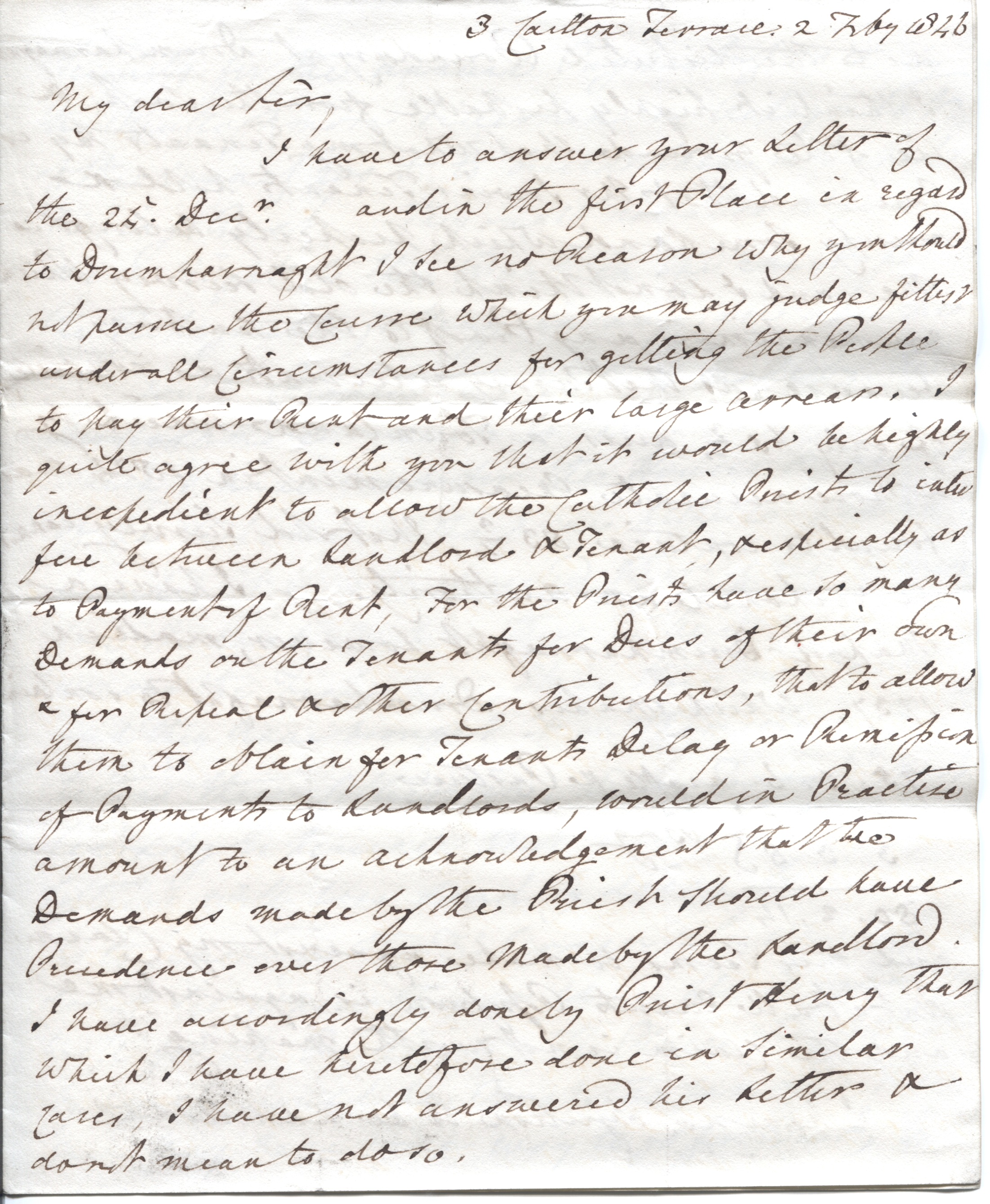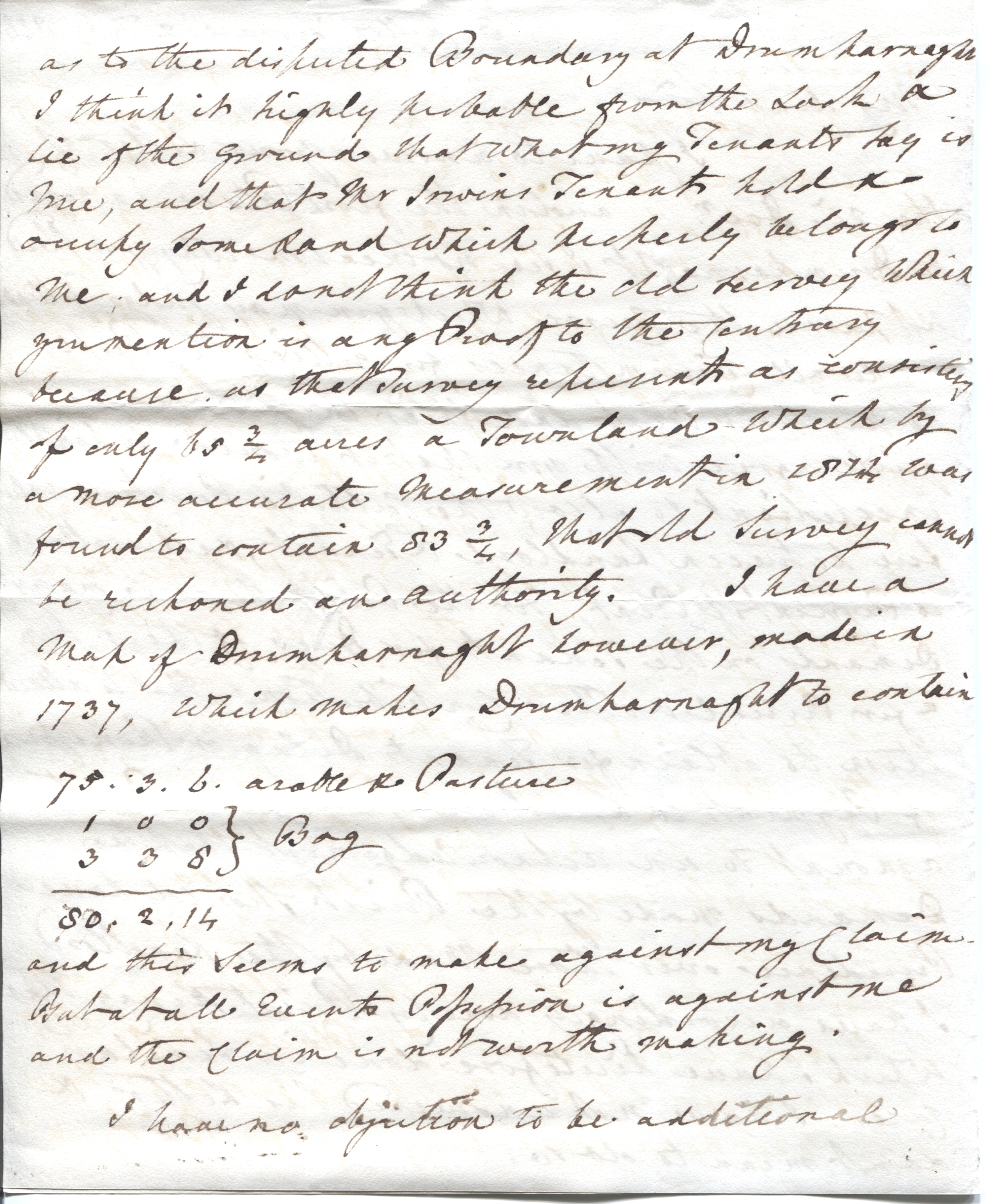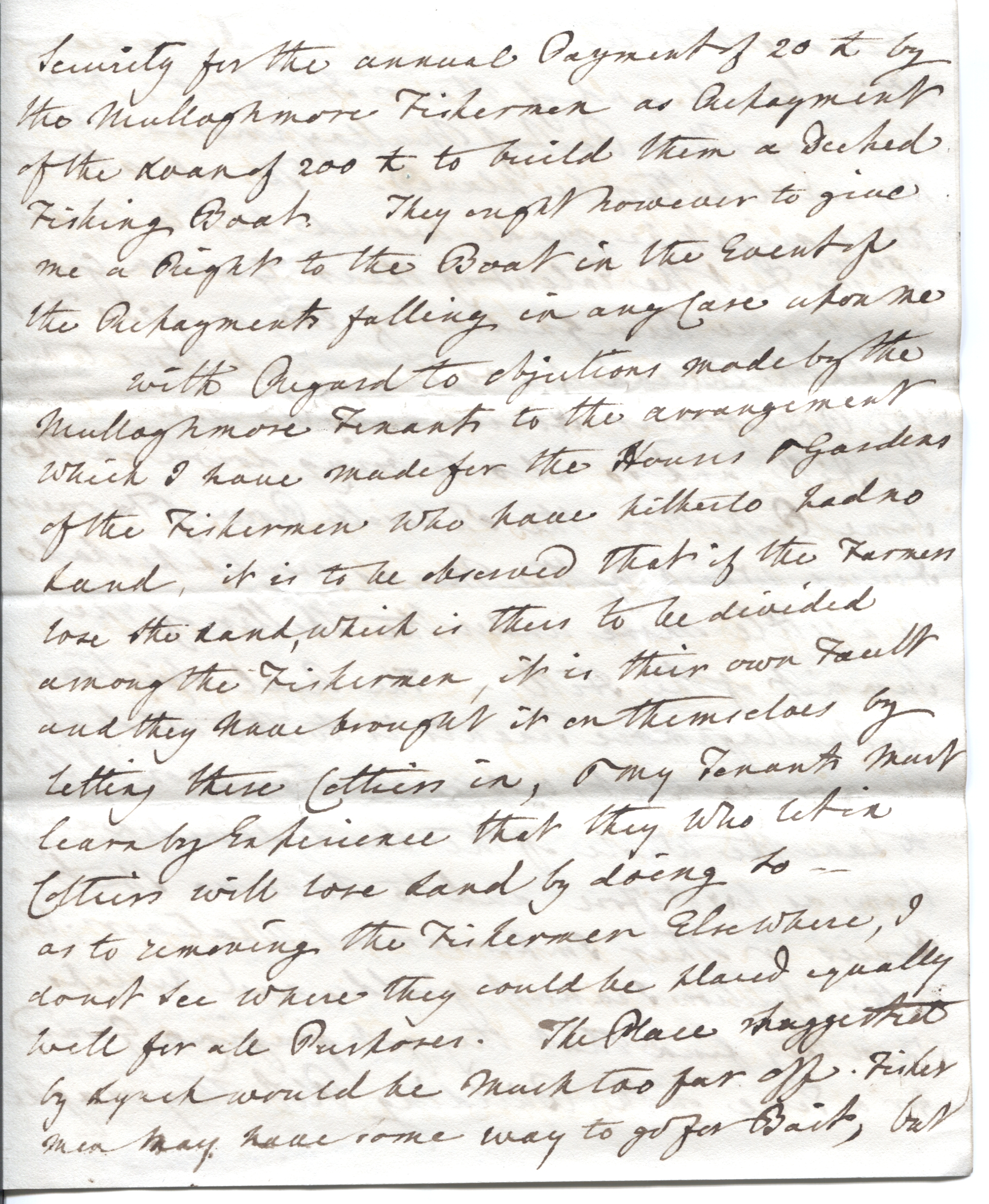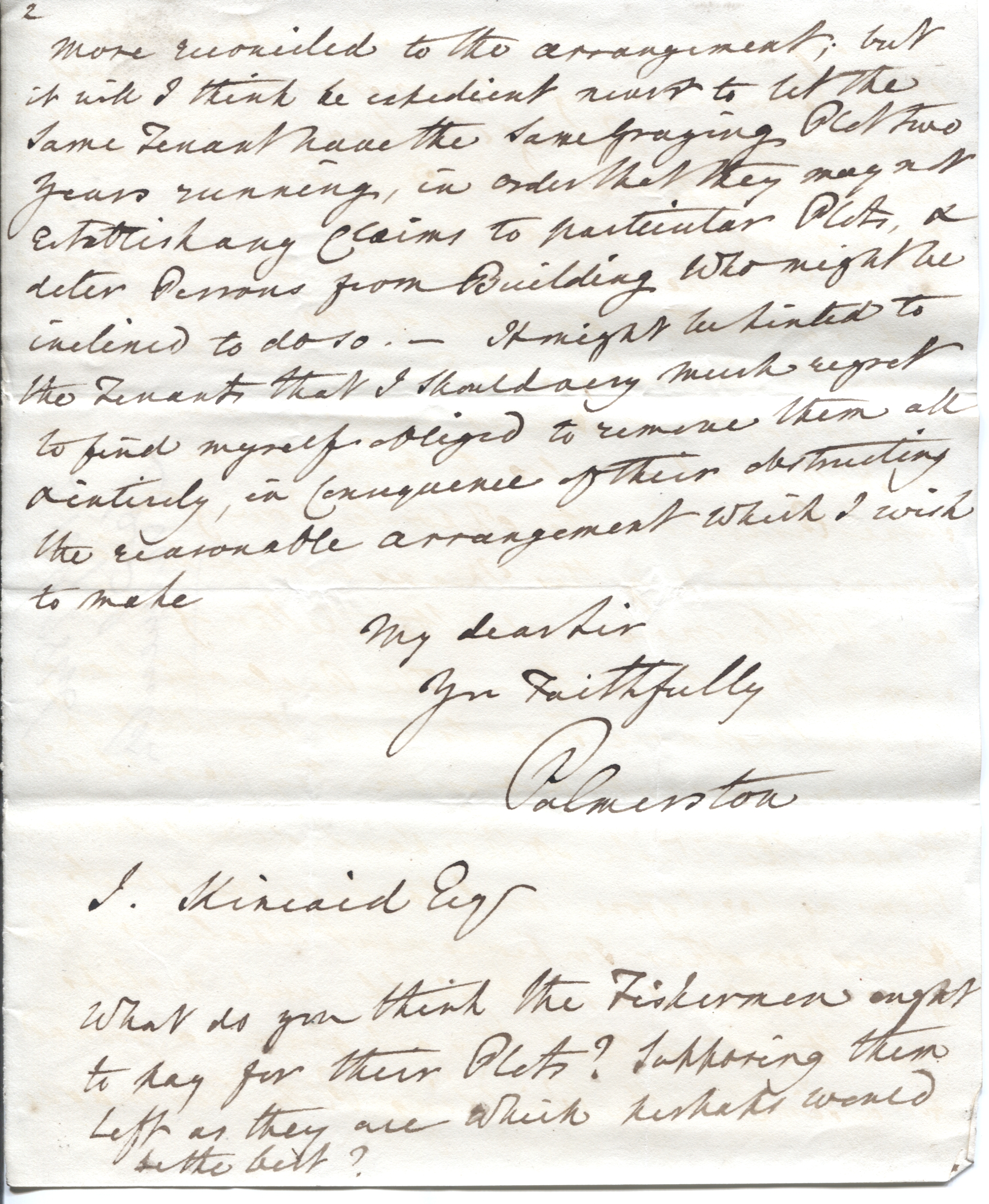
PALMERSTON WRITES TO HIS AGENT ABOUT HIS ESTATES IN IRELAND
PALMERSTON
(Henry John Temple, 1784-1865, Foreign Secretary and Prime Minister, 3rd Viscount)
Excellent long Autograph Letter Signed to J. Kincaid
replying to his letter "in the first Place in regard to Drumharnaghts I see no reason why you should not pursue the Course which you may judge fittest under the Circumstances for getting the People to pay their Rent and their large arrears. I quite agree with you that it would be highly inexpedient to allow the Catholic Priests to interfere between landlord & tenant, & especially as to Payment of Rent, for the Priests have so many demands on the Tenants for Dues of their own & for fiscal & other contributions, that to allow them to obtain for Tenants Delay or Remission of Payment to Landlords, would in Practice amount to an acknowledgement that the demands made by the Priest should have Precedence over those made by the Landlord. I have accordingly done by Priest Henry that which I have heretofore done in similar cases, I have not answered his letters & don't mean to do so. As to the disputed Boundary at Drumharnaght I think it highly probable from the look & lie of the Grounds that what my Tenants say is true, and that the Irwin's Tenants hold & occupy some land which properly belongs to me, and I do not think the old survey which you mention is any Proof to the Contrary because as that survey represents as consisting of only 65¾ acres a Townland which by a more accurate measurement in 1824 was found to contain 83¾, that old survey cannot be reckoned an authority. I have a map ... made in 1737 which make Drumharnaght to contain ... 80,2,14 and this seems to make against my Claim. But at all events Possession is against me and the claim is not worth making. I have no objection to be additional security for the annual Payment of 20£ by the Mullaghmore Fishermen as Repayment of the load of 200£ to buIld them a Decked Fishing Boat. They ought however to give me a Right to the Boat in the Event of the Repayment falling in any case upon me. With regard to objections made by the Mullaghmore Tenants to the arrangements which I have made for the Houses & Gardens of the Fishermen who have hitherto had no land, it is to be observed that if the Farmers lose the land, which is thus to be divided among the Fishermen, it is their own Fault and they have brought it on themselves by letting these Cottiers in, & my Tenants must learn by Experience that they who let in Cottiers will lose land by doing so. As to removing the Fishermen elsewhere, I do not see where they could be placed equally well for all purposes. The Place suggested by Lynch would be much too far off. Fishermen may have some way to go for Bait, but they ought to be within a short distance of their Boats and of their Harbour; nor is there any other Part of Mullaghmore where they could better be placed. The only alteration which might be made would be to Curtail by 50 or 100 feet, the extent of their Garden Ground and to give them gardens of 200 or of 250 feet in length instead of 300 feet, and thus to bring the Row of their Houses a little lower down the Hill and so also to bring down in the same proportion the opposite Row of Farmer's Houses, which by this means would perhaps be a little more under the shelter of the Summit of the Hill. The Real objection of the Mullaghmore Tenants is to the whole of my arrangement, & of course they would like to have the whole of the land divided among them as heretofore, and to have no streets or Houses or other Improvement whatever. But to this objection I cannot yield, and perhaps when they find that they get grazing ground for a Time on the Building Plots they may be more reconciled to the arrangement, but it will I think be expedient never to let the same Tenant have the same grazing Plot two years running, in order that they may not establish any Claims to particular Plots, & deter Persons from Building who might be inclined to do so - It might be hinted to the Tenants that I should very much regret to find myself obliged to remove them all ... in consequence of their obstructing the reasonable arrangement which I wish to make ..." ending with a postscript about the price of the Fishermen's plots, 5 sides 4to., 3 Carlton Terrace, 2nd February
Mullaghmore is a village on the Mullaghmore Peninsula in County Sligo. From the 17th to the 19th centuries it was part of the large estate belonging to the Temple family in north Sligo. The land, some 12,000 acres, was granted to Sir John Temple, 1st Viscount Palmerston and Master of the Rolls in Dublin. The 3rd Viscount, Henry John Temple, Lord Palmerston, began the building of the castle of Classiebawn on the peninsula, a baronial-style house designed by James Rawson Carroll. He also built the stone-walled harbour in the village, which was designed by the marine engineer Alexander Nimmo. It was built between 1822 and 1841. The Temples were mostly absentee landlords, with the estate being run initially by middlemen, and later by land agents, such as Stewart and Kincaid, a Dublin firm with offices in Sligo. These agents, in their attempts to make the estates profitable, oversaw the "assisted emigration" that took place on the Palmerston and adjacent Gore Booth (Lissadell) estate that began before the Great Famine and continued until at least the 1860s.
Lord Palmerston presided over Mullaghmore and North Sligo during the worst years of the Great Famine of the mid-19th century. During the summer and autumn of 1847, nine vessels, carrying over 2,000 persons left Sligo port with tenants evicted and "shovelled out" from his Sligo estates. They arrived in Canada half naked and totally destitute.
A Cottier is an Irish peasant holding land by cottier tenure.
Item Date:
1846
Stock No:
41670




<< Back